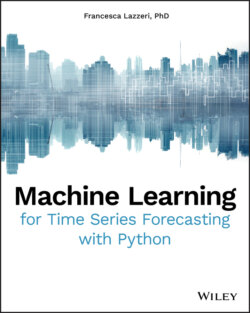Machine Learning for Time Series Forecasting with Python

Реклама. ООО «ЛитРес», ИНН: 7719571260.
Оглавление
Francesca Lazzeri. Machine Learning for Time Series Forecasting with Python
Table of Contents
List of Tables
List of Illustrations
Guide
Pages
Machine Learning for Time Series Forecasting with Python®
Introduction
What Does This Book Cover?
Reader Support for This Book
Companion Download Files
How to Contact the Publisher
How to Contact the Author
CHAPTER 1 Overview of Time Series Forecasting
Flavors of Machine Learning for Time Series Forecasting
Supervised Learning for Time Series Forecasting
Python for Time Series Forecasting
Experimental Setup for Time Series Forecasting
Conclusion
CHAPTER 2 How to Design an End-to-End Time Series Forecasting Solution on the Cloud
Time Series Forecasting Template
Business Understanding and Performance Metrics
Data Ingestion
Data Exploration and Understanding
Data Pre-processing and Feature Engineering
Modeling Building and Selection
An Overview of Demand Forecasting Modeling Techniques
Model Evaluation
Model Deployment
Forecasting Solution Acceptance
Use Case: Demand Forecasting
Conclusion
CHAPTER 3 Time Series Data Preparation
Python for Time Series Data
Common Data Preparation Operations for Time Series
Time stamps vs. Periods
Converting to Time stamps
Providing a Format Argument
Indexing
Time/Date Components
Frequency Conversion
Time Series Exploration and Understanding
How to Get Started with Time Series Data Analysis
Data Cleaning of Missing Values in the Time Series
Time Series Data Normalization and Standardization
Time Series Feature Engineering
Date Time Features
Lag Features and Window Features
Rolling Window Statistics
Expanding Window Statistics
Conclusion
CHAPTER 4 Introduction to Autoregressive and Automated Methods for Time Series Forecasting
Autoregression
Moving Average
Autoregressive Moving Average
Autoregressive Integrated Moving Average
Automated Machine Learning
Conclusion
CHAPTER 5 Introduction to Neural Networks for Time Series Forecasting
Reasons to Add Deep Learning to Your Time Series Toolkit
Deep Learning Neural Networks Are Capable of Automatically Learning and Extracting Features from Raw and Imperfect Data
Deep Learning Supports Multiple Inputs and Outputs
Recurrent Neural Networks Are Good at Extracting Patterns from Input Data
Recurrent Neural Networks for Time Series Forecasting
Recurrent Neural Networks
Long Short-Term Memory
Gated Recurrent Unit
How to Prepare Time Series Data for LSTMs and GRUs
How to Develop GRUs and LSTMs for Time Series Forecasting
Keras
TensorFlow
Univariate Models
Multivariate Models
Conclusion
CHAPTER 6 Model Deployment for Time Series Forecasting
Experimental Set Up and Introduction to Azure Machine Learning SDK for Python
Workspace
Experiment
Run
Model
Compute Target, RunConfiguration, and ScriptRunConfig
Image and Webservice
Machine Learning Model Deployment
How to Select the Right Tools to Succeed with Model Deployment
Solution Architecture for Time Series Forecasting with Deployment Examples
Train and Deploy an ARIMA Model
Configure the Workspace
Create an Experiment
Create or Attach a Compute Cluster
Upload the Data to Azure
Create an Estimator
Submit the Job to the Remote Cluster
Register the Model
Deployment
Define Your Entry Script and Dependencies
Automatic Schema Generation
Conclusion
References
Index
About the Author
About the Technical Editor
Acknowledgments
WILEY END USER LICENSE AGREEMENT
Отрывок из книги
Francesca Lazzeri, PhD
Currently, most of the resources and tutorials for machine learning model-based time series forecasting generally fall into two categories: code demonstration repo for certain specific forecasting scenarios, without conceptual details, and academic-style explanations of the theory behind forecasting and mathematical formula. Both of these approaches are very helpful for learning purposes, and I highly recommend using those resources if you are interested in understanding the math behind theoretical hypotheses.
.....
In the next section of this chapter, we will discuss how to shape time series as a supervised learning problem and, as a consequence, get access to a large portfolio of linear and nonlinear machine learning algorithms.
Machine learning is a subset of artificial intelligence that uses techniques (such as deep learning) that enable machines to use experience to improve at tasks (aka.ms/deeplearningVSmachinelearning). The learning process is based on the following steps:
.....